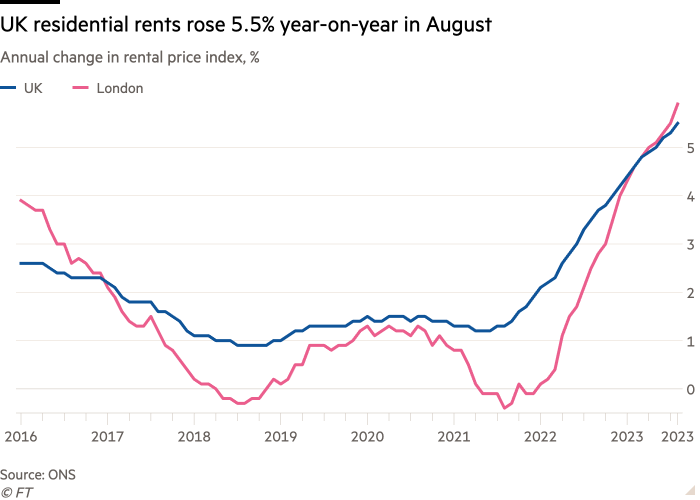Receive free Residential property updates
We’ll send you a myFT Daily Digest email rounding up the latest Residential property news every morning.
Residential rental costs increased at the fastest annual rate since records began seven years ago, while UK house price rises slowed to the lowest rate in a decade, according to official data published on Wednesday.
Private rents rose 5.5 per cent year on year in August, up slightly from 5.3 per cent in July, and the largest annual percentage increase since the Office for National Statistics data series began in January 2016.
Meanwhile, the annual growth in house prices dropped to 0.6 per cent in July, down from 1.9 per cent in June, to the slowest rate since September 2012, according to separate ONS data.
The trends in rental and house prices reflect the surge in mortgage rates over the past two years, which have made buying a property unaffordable for many, boosting demand for lettings in a constrained market, where landlords are also passing on their increased borrowing costs.
Emma Humphreys, Partner at the law firm Charles Russell Speechlys, said: “There are tenants struggling to pay their rent, and many landlords are being squeezed just as tightly, with rising mortgage payments and changes to tax reliefs forcing many to let go of their properties.”

Although lenders have started reducing mortgage rates in recent months, they are still close to 15-year highs, reflecting successive rate rises by the Bank of England from a record low of 0.1 per cent in November 2021 to 5.25 per cent.
The ONS data showed that rents in August rose at the fastest rate in Wales at 6.5 per cent, followed by Scotland at 6 per cent, while in England the average was 5.4 per cent. The data for Northern Ireland is for June, which showed a 9.1 per cent rise.
London’s annual rental price growth, at 5.9 per cent, was the highest of all English regions and at its highest annual rate since the data series began in January 2006.
The capital was also one of the outliers in house price trends, registering a 0.8 per cent year-on-year drop in July, although the south west of England saw a bigger fall of 1 per cent.
The average UK house price in July was £290,000, down £2,000 from the peak in November last year but still £59,200 higher than February 2020, the last month before the coronavirus pandemic hit.
Gabriella Dickens, economist at Pantheon Macroeconomics said, more recent data from Nationwide and Halifax, which showed house prices falling at the fastest annual rate since 2009 in August, meant that “further declines in the official index over the coming months look likely”.


Comments are closed, but trackbacks and pingbacks are open.